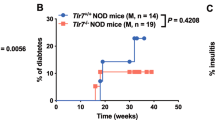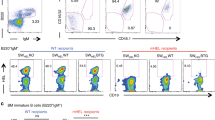Key Points
-
On B cells, CD22 and Siglec-G mediate inhibition of B-cell antigen receptor-induced signalling; Siglec-G is an inhibitory receptor for B1 cells
-
Ligand-binding of CD22 and Siglec-G to other membrane glycoproteins in cis regulate their association to the B-cell receptor and the degree of inhibition
-
CD22-deficiency or Siglec-G-deficiency does not result in autoimmunity, whereas CD22 and Siglec-G double-deficient mice develop a systemic lupus erythematosus (SLE)-like disease
-
The immunomodulatory CD22-specific antibody, epratuzumab, reduces disease activity in patients with SLE, although the exact mechanism is unknown
-
Attaching CD22-specific or Siglec-G-specific sialic acids with antigens on liposomes induces antigen-specific tolerance in mice and could be a new autoantigen-specific treatment strategy
Abstract
A high proportion of peripheral human B cells produce polyreactive or autoreactive antibodies, which indicates that they have escaped the elimination of self-reactive B cells in the bone marrow. CD22 and Siglec-G are two inhibitory receptors of the sialic-acid-binding immunoglobulin-like lectin (Siglec) family that inhibit the B-cell antigen receptor (BCR) signal. The ability of these two receptors to bind sialic acids is crucial for regulating inhibition and inducing tolerance to self-antigens. Sialylated glycans are usually absent on microbes (although several pathogenic microorganisms have evolved strategies to mimic self by decorating their surfaces with sialic acids) but abundant in higher vertebrates and might, therefore, provide an important tolerogenic signal. Combined Siglec-G deficiency and CD22 deficiency leads to spontaneous autoimmunity in mice, and mutations in an enzyme that modifies Siglec ligands are directly linked to several autoimmune diseases in humans. New data show that high-affinity ligands for CD22 and Siglec-G can be used to induce antigen-specific B-cell tolerance, which might be one strategy for the treatment of autoimmune diseases in the future.
This is a preview of subscription content, access via your institution
Access options
Subscribe to this journal
Receive 12 print issues and online access
$209.00 per year
only $17.42 per issue
Buy this article
- Purchase on Springer Link
- Instant access to full article PDF
Prices may be subject to local taxes which are calculated during checkout



Similar content being viewed by others
References
Tiegs, S. L., Russell, D. M. & Nemazee, D. Receptor editing in self-reactive bone marrow B cells. J. Immunol. 186, 1313–1324 (2011).
Wardemann, H. et al. Predominant autoantibody production by early human B cell precursors. Science 301, 1374–1377 (2003).
Crocker, P. R., Paulson, J. C. & Varki, A. Siglecs and their roles in the immune system. Nat. Rev. Immunol. 7, 255–266 (2007).
Nitschke, L., Carsetti, R., Ocker, B., Köhler, G. & Lamers, M. C. CD22 is a negative regulator of B-cell receptor signalling. Curr. Biol. 7, 133–143 (1997).
Hoffmann, A. et al. Siglec-G is a B1 cell-inhibitory receptor that controls expansion and calcium signaling of the B1 cell population. Nat. Immunol. 8, 695–704 (2007).
Munday, J. et al. Identification, characterization and leucocyte expression of Siglec-10, a novel human sialic acid-binding receptor. Biochem. J. 355, 489–497 (2001).
Whitney, G. et al. A new siglec family member, siglec-10, is expressed in cells of the immune system and has signaling properties similar to CD33. Eur. J. Biochem. 268, 6083–6096 (2001).
Otipoby, K. L., Draves, K. E. & Clark, E. A. CD22 regulates B cell receptor-mediated signals via two domains that independently recruit Grb2 and SHP-1. J. Biol. Chem. 276, 44315–44322 (2001).
Chen, J. et al. CD22 attenuates calcium signaling by potentiating plasma membrane calcium-ATPase activity. Nat. Immunol. 5, 651–657 (2004).
Hibbs, M. L. et al. Multiple defects in the immune system of Lyn-deficient mice, culminating in autoimmune disease. Cell 83, 301–311 (1995).
Bolland, S. & Ravetch, J. V. Spontaneous autoimmune disease in FcγRIIB-deficient mice results from strain-specific epistasis. Immunity 13, 277–285 (2000).
Jellusova, J., Wellmann, U., Amann, K., Winkler, T. H. & Nitschke, L. CD22 x Siglec-G double-deficient mice have massively increased B1 cell numbers and develop systemic autoimmunity. J. Immunol. 184, 3618–3627 (2010).
Doody, G. M. et al. A role in B cell activation for CD22 and the protein tyrosine phosphatase SHP. Science 269, 242–244 (1995).
Blasioli, J. Definition of the sites of interaction between the protein tyrosine phosphatase SHP-1 and CD22. J. Biol. Chem. 274, 2303–2307 (1999).
Fujimoto, M., Bradney, A. P., Poe, J. C., Steeber, D. A. & Tedder, T. F. Modulation of B lymphocyte antigen receptor signal transduction by a CD19/CD22 regulatory loop. Immunity 11, 191–200 (1999).
Gerlach, J. et al. B cell defects in SLP65/BLNK-deficient mice can be partially corrected by the absence of CD22, an inhibitory coreceptor for BCR signaling. Eur. J. Immunol. 33, 3418–3426 (2003).
Müller, J. et al. CD22 ligand-binding and signaling domains reciprocally regulate B-cell Ca2+ signaling. Proc. Natl Acad. Sci. USA 110, 12402–12407 (2013).
Pfrengle, F., Macauley, M. S., Kawasaki, N. & Paulson, J. C. Copresentation of antigen and ligands of Siglec-G induces B cell tolerance independent of CD22. J. Immunol. 191, 1724–1731 (2013).
Duong, B. H. et al. Decoration of T-independent antigen with ligands for CD22 and Siglec-G can suppress immunity and induce B cell tolerance in vivo. J. Exp. Med. 207, 173–187 (2010).
Han, S., Collins, B. E., Bengtson, P. & Paulson, J. C. Homomultimeric complexes of CD22 in B cells revealed by protein-glycan cross-linking. Nat. Chem. Biol. 1, 93–97 (2005).
Collins, B. E. et al. Masking of CD22 by cis ligands does not prevent redistribution of CD22 to sites of cell contact. Proc. Natl Acad. Sci. USA 101, 6104–6109 (2004).
Collins, B. E., Smith, B. a, Bengtson, P. & Paulson, J. C. Ablation of CD22 in ligand-deficient mice restores B cell receptor signaling. Nat. Immunol. 7, 199–206 (2006).
Lanoue, A., Batista, F. D., Stewart, M. & Neuberger, M. S. Interaction of CD22 with a2, 6-linked sialoglycoconjugates: innate recognition of self to dampen B cell autoreactivity? Eur. J. Immunol. 32, 348–355 (2002).
Cao, H. & Crocker, P. R. Evolution of CD33-related siglecs: regulating host immune functions and escaping pathogen exploitation? Immunology 132, 18–26 (2011).
Angata, T., Margulies, E. H., Green, E. D. & Varki, A. Large-scale sequencing of the CD33-related Siglec gene cluster in five mammalian species reveals rapid evolution by multiple mechanisms. Proc. Natl Acad. Sci. USA 101, 13251–13256 (2004).
Otipoby, K. L. et al. CD22 regulates thymus-independent responses and the lifespan of B cells. Nature 384, 634–637 (1996).
Sato, S. et al. CD22 is both a positive and negative regulator of B lymphocyte antigen receptor signal transduction: altered signaling in CD22-deficient mice. Immunity 5, 551–562 (1996).
O'Keefe, T. L., Williams, G. T., Batista, F. D. & Neuberger, M. S. Deficiency in CD22, a B cell-specific inhibitory receptor, is sufficient to predispose to development of high affinity autoantibodies. J. Exp. Med. 189, 1307–1313 (1999).
Mary, C. et al. Cd22a PRE-mRNA dysregulated expression of the Cd22 gene as a result of a short interspersed nucleotide element insertion in Cd22a lupus-prone mice. J. Immunol. 165, 2987–2996 (2000).
Nitschke, L. et al. Expression of aberrant forms of CD22 on B lymphocytes in Cd22a lupus-prone mice affects ligand binding. Int. Immunol. 18, 59–68 (2006).
Cariappa, A. et al. B cell antigen receptor signal strength and peripheral B cell development are regulated by a 9-O-acetyl sialic acid esterase. J. Exp. Med. 206, 125–138 (2009).
Sjoberg, E. R., Powell, L. D., Klein, A. & Varki, A. Natural ligands of the B cell adhesion molecule CD22β can be masked by 9-O-acetylation of sialic acids. J. Cell Biol. 126, 549–562 (1994).
Surolia, I. et al. Functionally defective germline variants of sialic acid acetylesterase in autoimmunity. Nature 466, 243–247 (2010).
Murakami, M., Yoshioka, H., Shirai, T., Tsubata, T. & Honjo, T. Prevention of autoimmune symptoms in autoimmune-prone mice by elimination of B-1 cells. Int. Immunol. 7, 877–882 (1995).
Harley, I. T. W., Kaufman, K. M., Langefeld, C. D., Harley, J. B. & Kelly, J. A. Genetic susceptibility to SLE: new insights from fine mapping and genome-wide association studies. Nat. Rev. Genet. 10, 285–290 (2009).
Cui, Y., Sheng, Y. & Zhang, X. Genetic susceptibility to SLE: recent progress from GWAS. J. Autoimmun. 41, 25–33 (2013).
Dörner, T. & Lipsky, P. E. B cells: depletion or functional modulation in rheumatic diseases. Curr. Opin. Rheumatol. 26, 228–236 (2014).
Duxbury, B., Combescure, C. & Chizzolini, C. Rituximab in systemic lupus erythematosus: an updated systematic review and meta-analysis. Lupus 22, 1489–1503 (2013).
Liossis, S. N., Kovacs, B., Dennis, G., Kammer, G. M. & Tsokos, G. C. B cells from patients with systemic lupus erythematosus display abnormal antigen receptor-mediated early signal transduction events. J. Clin. Invest. 98, 2549–2557 (1996).
Jacobi, a M. et al. Differential effects of epratuzumab on peripheral blood B cells of patients with systemic lupus erythematosus versus normal controls. Ann. Rheum. Dis. 67, 450–457 (2008).
Wallace, D. J. et al. Efficacy and safety of epratuzumab in patients with moderate/severe active systemic lupus erythematosus: results from EMBLEM, a phase IIb, randomised, double-blind, placebo-controlled, multicentre study. Ann. Rheum. Dis. 73, 183–190 (2014).
Wöhner, M., Born, S. & Nitschke, L. Human CD22 cannot fully substitute murine CD22 functions in vivo, as shown in a new knockin mouse model. Eur. J. Immunol. 42, 3009–3018 (2012).
Carnahan, J. et al. Epratuzumab, a humanized monoclonal antibody targeting CD22: characterization of in vitro properties. Clin. Cancer Res. 9, 3982S–3990S. (2003).
Sieger, N. et al. CD22 ligation inhibits downstream B cell receptor signaling and Ca2+ flux upon activation. Arthritis Rheum. 65, 770–779 (2013).
Rossi, E. a. et al. Trogocytosis of multiple B-cell surface markers by CD22 targeting with epratuzumab. Blood 122, 3020–3029 (2013).
Kelm, S. The ligand-binding domain of CD22 is needed for inhibition of the B Cell receptor signal, as demonstrated by a novel human CD22-specific inhibitor compound. J. Exp. Med. 195, 1207–1213 (2002).
Schweizer, A., Wöhner, M., Prescher, H., Brossmer, R. & Nitschke, L. Targeting of CD22-positive B-cell lymphoma cells by synthetic divalent sialic acid analogues. Eur. J. Immunol. 42, 2792–2802 (2012).
Collins, B. E. et al. High-affinity ligand probes of CD22 overcome the threshold set by cis ligands to allow for binding, endocytosis, and killing of B cells. J. Immunol. 177, 2994–3003 (2006).
Courtney, A. H., Puffer, E. B., Pontrello, J. K., Yang, Z.-Q. & Kiessling, L. L. Sialylated multivalent antigens engage CD22 in trans and inhibit B cell activation. Proc. Natl Acad. Sci. USA 106, 2500–2505 (2009).
Macauley, M. S. et al. Antigenic liposomes displaying CD22 ligands induce antigen-specific B cell apoptosis. J. Clin. Invest. 123, 3074–3083 (2013).
Nitschke, L. Suppressing the antibody response with Siglec ligands. N. Engl. J. Med. 369, 1373–1374 (2013).
Kelm, S. et al. C-4 modified sialosides enhance binding to Siglec-2 (CD22): towards potent Siglec inhibitors for immunoglycotherapy. Angew. Chem. Int. Ed. Engl. 52, 3616–3620 (2013).
Nitschke, L. The role of CD22 and other inhibitory co-receptors in B-cell activation. Curr. Opin. Immunol. 17, 290–297 (2005).
Acknowledgements
The authors are supported by grants from the Deutsche Forschungsgemeinschaft (SFB643, TRR130).
Author information
Authors and Affiliations
Contributions
J.M. and L.N. contributed equally to researching data for the article and writing the article. L.N. reviewed and edited the manuscript before submission.
Corresponding author
Ethics declarations
Competing interests
L.N. received grants for research from UCB Pharma. J.M. declares no competing interests.
Rights and permissions
About this article
Cite this article
Müller, J., Nitschke, L. The role of CD22 and Siglec-G in B-cell tolerance and autoimmune disease. Nat Rev Rheumatol 10, 422–428 (2014). https://doi.org/10.1038/nrrheum.2014.54
Published:
Issue Date:
DOI: https://doi.org/10.1038/nrrheum.2014.54
This article is cited by
-
Emerging phagocytosis checkpoints in cancer immunotherapy
Signal Transduction and Targeted Therapy (2023)
-
The intriguing roles of Siglec family members in the tumor microenvironment
Biomarker Research (2022)
-
Galectin-9 binds IgM-BCR to regulate B cell signaling
Nature Communications (2018)
-
Decreased CD22 expression and intracellular signaling aberrations in B cells of patients with systemic sclerosis
Rheumatology International (2018)
-
Calcium Signaling: From Normal B Cell Development to Tolerance Breakdown and Autoimmunity.
Clinical Reviews in Allergy & Immunology (2017)



